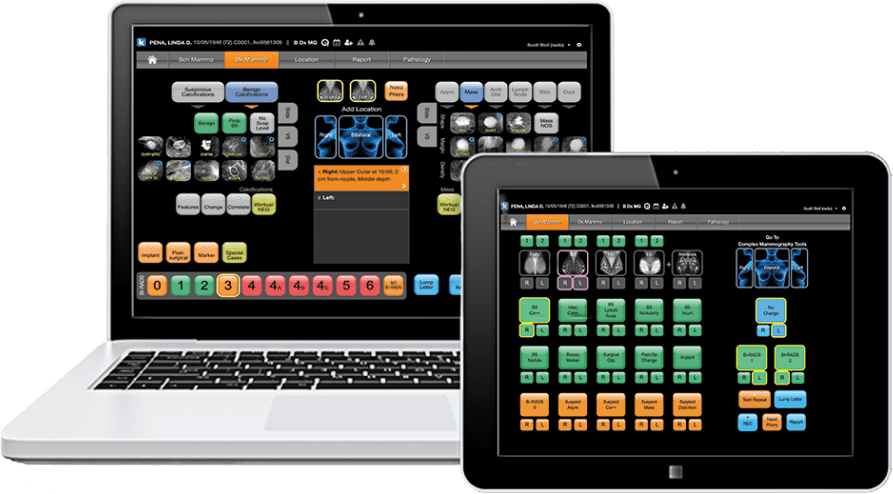Table of contents
Patients First
The first step is completing the risk assessment questionnaire which contains detailed questions about the patient and their extended family’s history of breast and ovarian cancer and BRCA testing.
The questionnaire is available in any patient language and the preferred patient language is saved along with answers and translated into English. The patient result and reminder letters automatically default to the chosen patient language. Patients will be asked to update their questionnaires at future visits, but info from previous visits autopopulate for them. Typically, it takes three to six minutes on the first visit to complete the questionnaire and as little as 30 seconds on return visits. The intake process is quick, informative, and establishes trust between the patient and the practice’s staff and enables non-English speakers the same care as English speakers. Timely follow through is critically important for both the patient and staff. Breast health requires being proactive in healthcare.
- Risk assessment: Ikonopedia offers an online Tyrer-Cuzick Model Breast Cancer Risk evaluation tool for anyone to use. We want breast health risk assessment to be accessible to all women. While this should never replace a visit to a doctor, it is a great patient education and empowerment tool.
- Easy intake: Ikonopedia enables online collection of patient information prior to patient appointment through a portal or at the physician’s office using a tablet device. Ikonopedia offers flexibility and increased efficiency.
- Timely follow through: The resolution manager uses the lesion specific patient tracking information to correlate pathology results and resolve each area of concern, tracking pathology results directly into individual locations.

Radiologist and Technologist-Centered
Ikonopedia was started by internationally recognized breast health radiologists – Dr. László Tabár, Dr. Tom Stavros, and Dr. Michael Vendrell. Their goal is to offer a more complete, understandable, and closed-loop system so women and men with potential breast cancer issues receive the care and resolution they deserve as quickly and safely as possible. Workflow options are optimized from patient check-in all the way to reporting and follow-up.
- Ease of diagnosing: Patient history automatically pre-populates the clinical section of the physician report and density and previous locations are carried to the next appropriate report as well. The system increases radiologists’ awareness with clinical warnings and provides timely alerts of relevant patient and family history during the reporting process. Radiologists have safety checks on their recommendations which prevents them from signing a report if there’s a conflict. There are both critical alerts which prevent signing a dangerous report or a report that conflicts with BI-RADS® and soft alerts which still allow the report to be signed. In all cases Ikonopedia completely replaces the need for any manual QA process.
- Workflow enabled: Ikonopedia supports many workflows and are customized for your practice during the implementation ensuring efficiency and safety gains.
- Icons for insights: Teaching files and teaching images from Drs. Tabár, Stavros, and Vendrell are used as icons to assist in making the patient diagnosis and to streamline the reporting process. They are patented, visual reporting solutions.

IT Empowered
Ikonopedia is cloud-based and partners with Amazon Web Services for high availability and superior performance (multiple servers and multiple availability zones). The system integrates seamlessly with Radiology Information Systems (RIS) and Picture Archive and Communications Systems (PACS). Ikonopedia has additional integrations with artificial intelligence and breast density partners to aid in radiologist reporting. The company also conducts SOC 2 (Service and Organizational Controls) audits validating securities adherence to ensure your data remains safe. In addition, the company manages all backups, HIPAA and internet security, upgrades, and customer support.

- Integrations: Ikonopedia integrates fully with RIS, PACS, and enterprise patient portals. Additional integrations include partnering with artificial intelligence triage and breast density applications for enhanced reporting. AI and density Integrations provide alerts, automated findings, and locations directly populate within Ikonopedia.
- Cloud-based: Provides customers with more flexible deployment options by leveraging web services and APIs. SaaS solutions also have lower cost of ownership over time versus server-based solutions. One major benefit is that you’re always on the latest version without costly upgrade fees or processes. Ikonopedia manages the servers and upgrades for your in our secure cloud-based environment. Ikonopedia is hosted in multiple availability zones so there are no worries about downtime.
- Security: Ikonopedia strictly follows HIPAA guidelines and industry best-practices to secure data, both from accidental loss and from malicious attack and/or theft. All personal health information (PHI) in Ikonopedia is encrypted and data is stored in a separate database for each customer — further isolating potential threats or attacks. Ikonopedia uses next-generation security to ensure complete safety.
Operations Enabled
Ikonopedia gathers patient information through a patient-centric, risk assessment questionnaire that is available in any patient language. Patients can fill out questionnaires on tablets in the patient portal of the practice or when they present for their appointment on any web enabled device, kiosk, or desktop. Ikonopedia is designed as a closed-loop system to track every lesion and concern to complete resolution. There is no limit to the number of lesion-specific findings you can add. Each finding is automatically created and tracked – improving patient safety and eliminating manual processes.
- Efficient patient information gathering: The patient questionnaire is the primary means of information gathering and the practice’s staff can also ask questions that pertain to the patients’ demographic, or their environment, to assist in obtaining additional relevant information. After the patient fills out the questionnaire, alerts are updated for your staff for review. If the patient returns for additional exams, they will be asked again to update any changes to the questionnaire, which may trigger additional alerts.
- Robust tracking: Patients are tracked every year for their annual exams as well as tracked for their individual exams or appointments in between. When the radiologist reports specific findings, the recommendations are automated and if there are multiple findings, every single lesion is tracked through the reporting process until resolution.
- Complete follow through: Patients are sent result and reminder letters in their preferred language selected. The letters are dynamic and built on the fly uniquely for each patient based on the selections made by the physician in the report. Ikonopedia can also send a copy of the patient letter to the customer RIS for additional tracking or delivery via patient portals. Individual findings are tracked by the Follow-up Manager and each concern is taken through customer-defined, multi-protocol steps for resolution. The Follow-up Manager also assists the customer in contacting the patient to schedule an appointment, follow up on pathology, or engage the referring physician when necessary. Protocol steps can include multiple letters and phone call reminders to ensure compliance and full communications to the patient.


Analytically Robust
Ikonopedia automates the annual MQSA audits to provide immediate and easy access to reports for for technologist counts, radiologist audits, breast screening audits, and many other reports. Ikonopedia’s platform includes the Insight Analytics tool which provides comprehensive end-to-end reporting and deep mining analytic capabilities of any data point. These analytics help identify the types of cancer, breast tissue density, compliance, and other high-risk indicators by age group to help assist in managing patient populations.
- Tools: In addition to the multitude of built in administrative and analytic reporting, Ikonopedia Insight helps breast imaging facilities utilize data for dashboards and enterprise reporting for better patient care and improve practice efficiency. Ikonopedia Insight uses data from customers’ patient intake information, imaging data, and clinical risk assessments to provide end-to-end visualization of patient care, from screening to treatment and follow up.
- Research: Ikonopedia’s rich data and simplified reporting has aided multiple organizations in research, learning, optimization, and ultimately best care in breast imaging.
Notice of Privacy (HIPAA)
Effective date of notice: February 4, 2013
Purpose of this Notice
Ikonopedia respects the privacy of protected health information and understands the importance of keeping this information confidential and secure. This Notice describes how we protect the confidentiality of the protected health information we receive.
Health Insurance Portability and Accountability Act of 1996 (HIPAA)
Ikonopedia maintains a comprehensive system to ensure compliance with applicable provisions of the Health Insurance Portability and Accountability Act of 1996 (HIPAA). Since our goal is to provide the highest level of service to our customers and business partners, we want you to know how Ikonopedia complies with the HIPAA directives. Our HIPAA Privacy Policy contains procedures addressing the protection, use and disclosure of protected health information (“PHI”), accounting of disclosures, access by individuals and third parties to PHI, protection of PHI by contractors, business associate agreements and training of employees.
How We Protect Personal Information
We treat personal information securely and confidentially. We limit access to personal information to only those persons who need to know that information to provide support services to our customers. These persons are trained on the importance of safeguarding this information and must comply with our procedures and applicable laws. We employ strict physical, electronic and procedural security standards (fully encrypted PHI) to protect personal information and maintain internal procedures to promote the integrity and accuracy of that information.
Disclosure of Personal Information
We may use or disclose protected health information to the Food and Drug Administration (“FDA”) in connection with the reporting of adverse events, product defects or problems, product tracking or for other purposes as required by the FDA. We may use or disclose de-identified protected health information during the course of clinical research activities. We may also disclose personal information as required by law.
Individual Rights to Access and Correct Personal Information
We have procedures in place for individuals to have access to protected health information, and procedures in place to ensure the integrity of our information and for the timely correction of incorrect information. You may contact our HIPAA privacy officer (listed below) to access to your protected health information.
We Want to Hear From You
Call for a demo or request more information.
Social Media